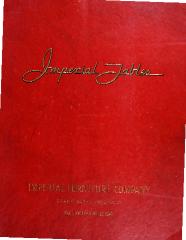Comments and Tags
Be the first to comment on this item!
Furniture ➔ Drop Leaf Table
Identifier:
140183Description:
This drop leaf table was manufactured by Imperial Furniture Company around 1940. It is made of mahogany and was adapted by one made by Duncan Phyfe between 1800 and 1815. The tabletop has two hinged sides with scalloped corners that can raise to create a larger surface or drop to create more space. It has one dovetail-constructed drawer with a pull knob and two turned decorations on the bottom of each front corner. The turned pedestal features carved foliate designs and stands on four carved legs with lion feet on casters.This table is featured on page 21 of the Imperial Furniture Company trade catalog, accession number 190920 from 1940-1941.
Marks and Labels
-"Imperial Grand Rapids | Exterior Surfaces | All Mahogany | In Accordance to Grand Rapids Standards": Green and gold maker label on the interior of the drawer
-"True Grand Rapids | Cabinet Making Certified | I-35351 | Trademark": Metal label from the Grand Rapids Furniture Makers Guild
Date:
circa 1940Materials:
Mahogany, MetalDimensions:
28.25" h 25.25" w 24" d; 28.25" h 48.5" w 24" dCurrent Location Status:
In StorageCollection Tier:
Tier 2Source:
Gift of the Grand Rapids Furniture MuseumRelated Entities:
Imperial Furniture Company (creator)Located in Grand Rapids, Michigan
SEE ALSO Grand Rapids Chair Co.; Bergsma Brothers
COMPANY HISTORY
1903: Founded by F. Stuart Foote.
1904: First dividend of 5% common stock declared.
1936: $80,000 showroom and dining hall built adjacent to factory.
1940s: Company builds airplane wings for the government.
1954: Company sold to Bergsma Brothers Co. after Foote dies.
PERSONNEL
F. Stuart Foote began at the Grand Rapids Chair Co., which his father, E.H. Foote, owned. There he learned about many aspects of the furniture business. In 1903, after ten years at the Grand Rapids Chair Co., he raised the money to found Imperial Furniture Co., with the help of Daniel McCoy, who was the president of Kent State Bank. McCoy was the first president of the company but Foote would soon take over and continue to be president for fifty years.
PRODUCTS
Imperial’s primary product were tables, with the addition of bookcases to its line later in its history. Foote laid claim to inventing the “coffee table” after he helped his wife prepare for a party by lowering the legs on a table. Imperial made dining room tables to go along with buffets made by the Grand Rapids Chair Co. Imperial was the first factory to bring out Duncan Phyfe reproductions. They worked mostly in mahogany but also had pieces of cherry. In the 1940s, they made wood airplane wings for the government. Imperial was the first company to concentrate large-scale efforts on occasional furniture.
MARKS AND LABELS
Through most of its history, Imperial’s trademark was a triangular shield with a crown on top. On the shield is written “Imperial, Grand Rapids, Michigan”. The crown and the lettering vary only slightly by date. Grand Rapids Furniture Museum (donor)
The Grand Rapids Furniture Museum opened in 1936 and was located at 427 Fulton Street. In 1959, the Museum closed and its collection was transferred to the Grand Rapids Public Museum. Grand Rapids Furniture Makers Guild (is related to)
The "Guild" was an independent organization within the Grand Rapids furniture industry whose mission focused on strengthening the business between the manufacturers and the dealers in presentation and sale to the public. The Guild operated independently from the Furniture Manufacturers Association of Grand Rapids (FMA), which promoted activities for the Furniture Market event and protected the "Grand Rapids Made" trademark. The formation of the Grand Rapids Furniture Makers Guild in 1931 accomplished several goals: it provided a new avenue for marketing Grand Rapids furniture during the Depression; it ensured that a large number of retail dealers would consistently carry Grand Rapids goods; it educated the general public about style and craftsmanship in furniture, and it advanced the reputation of Grand Rapids as the place where high-quality furnishings were made.
The Guild initially included nine Grand Rapids furniture manufacturers and increased to around 15 at its height. It was formed under the assumption that the "Grand Rapids" name and reputation held stronger sway with the buying public than did any of the individual company names. To capitalize on this, member companies sold their products through official "Guild" dealers across the country, and their products were labeled with a tag that often read "True Grand Rapids Cabinet Making Certified" instead of the individual company names. Each piece of furniture sold under the Guild name was numbered, and the buyer was given a certificate proving its pedigree as a Guild product. The tags usually take the form of a letter, followed by 5 digit number (such as I-46965), and researchers believe the letter indicates the name of the company that produced the piece. The Guild disbanded around the year 1967.
I - Imperial Furniture Company
G -
F - John Widdicomb Company
